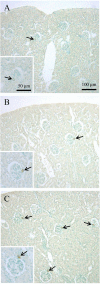Novel intrauterine growth retardation model: effects of maternal subtotal nephrectomy on neonates
- PMID: 35908938
- PMCID: PMC9523287
- DOI: 10.1292/jvms.22-0025
Novel intrauterine growth retardation model: effects of maternal subtotal nephrectomy on neonates
Abstract
Changes in body weight (BW), systolic blood pressure (SBP), and localization of renin in the kidneys of neonates born to normal mothers (C neonates) or to five-sixths (5/6) nephrectomized (2/3 left kidney and right kidney) mothers (Nx neonates) were studied. Maternal 5/6 nephrectomy caused weight loss in neonates but no differences in SBP or renin localization. Culling Nx neonates to a litter of 3 at 1 day after birth resulted in growth catching up with C neonates from 3 weeks old and increases in both SBP and renin-positive cells in neonatal kidney. These findings revealed that maternal 5/6 nephrectomy results in low-birth-weight neonates and that these neonates are at increased risk of metabolic syndrome by catch-up growth.
Keywords: intrauterine growth retardation; maternal subtotal nephrectomy; neonatal rat kidney.
Conflict of interest statement
The authors declare that there are no conflicts of interest.
Figures

Similar articles
-
Maternal protein restriction that does not have an influence on the birthweight of the offspring induces morphological changes in kidneys reminiscent of phenotypes exhibited by intrauterine growth retardation rats.Congenit Anom (Kyoto). 2016 Mar;56(2):79-85. doi: 10.1111/cga.12143. Congenit Anom (Kyoto). 2016. PMID: 26537761
-
Effects of maternal subtotal nephrectomy on the development of the fetal kidney: A morphometric study.Congenit Anom (Kyoto). 2015 Nov;55(4):178-82. doi: 10.1111/cga.12116. Congenit Anom (Kyoto). 2015. PMID: 26036181
-
Postnatal catch-up growth induced by growth hormone and insulin-like growth factor-I in rats with intrauterine growth retardation caused by maternal protein malnutrition.Pediatr Res. 1997 Sep;42(3):370-7. doi: 10.1203/00006450-199709000-00019. Pediatr Res. 1997. PMID: 9284279
-
[Molecular mechanisms of nephro-protective action of enalapril in experimental chronic renal failure].Ann Acad Med Stetin. 1999;Suppl 52:1-93. Ann Acad Med Stetin. 1999. PMID: 10589103 Review. Polish.
-
[Pathogenesis of fetal growth retardation and behavioral disorders in the progeny caused by smoking during pregnancy].Vestn Akad Med Nauk SSSR. 1989;(3):42-50. Vestn Akad Med Nauk SSSR. 1989. PMID: 2658400 Review. Russian.
References
-
- Boubred F, Daniel L, Buffat C, Feuerstein JM, Tsimaratos M, Oliver C, Dignat-George F, Lelièvre-Pégorier M, Simeoni U. 2009. Early postnatal overfeeding induces early chronic renal dysfunction in adult male rats. Am J Physiol Renal Physiol 297: F943–F951. doi: 10.1152/ajprenal.90704.2008 - DOI - PubMed

